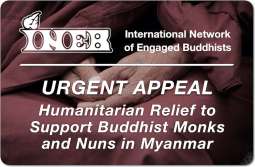三世
triloka[tiloka] three worlds. The three worlds are kāmaloka, rūpaloka and arūpaloka.
(1) kāmaloka [kāmaloka] the sensuous world
The sensuous world means the world of five senses. It consists of hells, the animal kingdom, the ghost realm, the demon-world, the realm of human beings, and the six lower worlds of Gods. Of these the first four are considered as unhappy states of existence (durgati) [duggati] and the others, happy ones (sugati). In the hell, that is, niraya the beings atone for their karma. Evil karma leads to the birth in the animal kingdom. The ghosts possess physical form which cannot be seen by the human eye. They live in places such as forests. The demons -- asura-s -- are unhappy beings who are deprived of light. Pain and pleasure both exist in the realm of the human beings.
The lowest of the heavenly realm is known as the Cāturmahārājika [Cātummahārājika] which is the abode of the guardian deities of the four quarters of the sky. Trayastriṃśat [tāvatiṃsa] that is, thirty-three, is the celestial realm of thirty-three Gods headed by the King Śakra. Yāma is the realm belonging to Yama. The Sanskrit root tuṣ means to be happy. Hence, tuṣita [tusita], the realm of delight is the plane of the satisfied beings. The Bodhisattva-s who are to be born as Buddha-s inhabit this plane.
(2) rūpaloka [rūpaloka] the world of formThe world of form, the second division of the threefold world, is considered to be above the world of desire. The inhabitants of this world have physical bodies. Their sense-faculties are temporarily withheld in the four absorptions. They are free from desires and sustain on light. The Gods who have practised certain dhyāna-s are the inhabitants of this world. It is linked to the four dhyāna-s. This world consists of sixteen realms pertaining to the four dhyāna-s as follows:The first dhyāna
1. The realm of Brahmā's retinue
2. The realm of Brahmā's priests
3. The realm of Great Brahmā
The second dhyāna
4. The realm of the Gods of limited lustre
5. The realm of the Gods of infinite lustre
6. The realm of the radiant Brahmā Gods
The third dhyāna
7. The realm of the Brahmā Gods of minor aura
8. The realm of the Brahmā Gods of infinite aura
9. The realm of the Brahmā Gods of steady aura
The fourth dhyāna
10. The realm of Brahmā Gods of great reward
11. The realm of mindless beings
12. The pure abodes are the realms of Gods which are further subdivided into:
(A) The durable realm
(B) The serene realm
(C) The beautiful realm
(D) The clear-sighted realm
(E) The highest realm.
(3) Ārūpyaloka [Āruppaloka or Arūpaloka] world of formlessnessĀrūpyaloka means the spiritual world. This world has no perceptible form; it has no substance. One can reach this world through meditation. Those who have attained the four stages of formlessness inhabit this world. It is divided into four planes such as
(A) the sphere of the conception of infinite space (ākāśānantyāyatana) [ākāsānañcāyatana], that is, the realm in which nothing is substantial.
(B) the sphere of the conception of infinite consciousness (vijñānānantyāyatana) [viññāṇānañcāyatana], that is, the realm in which nothing is substantial;the realm in which consciousness alone exists.
(C) the sphere of the conception of nothingness (ākiṃcanyāyatana) [ākiñcaññāyatana], that is, the realm of non-existence.
(D) the sphere of neither perception nor non-perception -- (naivasaṃjñānāsaṃjñāyatana) [n'eva saññā nāsaññāyatana], that is, the realm where there is neither thought nor no-thought.













